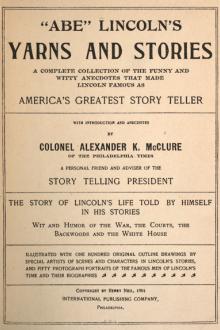Xerxes by Jacob Abbott (good books for 7th graders TXT) 📕

- Author: Jacob Abbott
- Performer: -
Book online «Xerxes by Jacob Abbott (good books for 7th graders TXT) 📕». Author Jacob Abbott
Herodotus adds that, besides the five millions regularly connected with the army, there was an immense and promiscuous mass of women, slaves, cooks, bakers, and camp followers of every description, that no human powers could estimate or number.
Dress and equipments.
Uncouth costumes.
But to return to the review. The numbers of the army having been ascertained, the next thing was to marshal and arrange the men by nations under their respective leaders, to be reviewed by the king. A very full enumeration of these divisions of the army is given by the historians of the day, with minute descriptions of the kind of armor which the troops of the several nations wore. There were more than fifty of these nations in all. Some of them were highly civilized, others were semi-barbarous tribes; and, of course, they presented, as marshaled in long array upon the plain, every possible variety of dress and equipment. Some were armed with brazen helmets, and coats of mail formed of plates of iron; others wore linen tunics, or rude garments made of the skins of beasts. The troops of one nation had their heads covered with helmets, those of another with miters, and of a third with tiaras. There was one savage-looking horde that had caps made of the skin of the upper part of a horse's head, in its natural form, with the ears standing up erect at the top, and the mane flowing down behind. These men held the skins of cranes before them instead of shields, so that they looked like horned monsters, half beast and half bird, endeavoring to assume the guise and attitude of men. There was another corps whose men were really horned, since they wore caps made from the skins of the heads of oxen, with the horns standing. Wild beasts were personated, too, as well as tame; for some nations were clothed in lions' skins, and others in panthers' skins—the clothing being considered, apparently, the more honorable, in proportion to the ferocity of the brute to which it had originally belonged.
The lasso.
The weapons, too, were of every possible form and guise. Spears—some pointed with iron, some with stone, and others shaped simply by being burned to a point in the fire; bows and arrows, of every variety of material and form, swords, daggers, slings, clubs, darts, javelins, and every other imaginable species of weapon which human ingenuity, savage or civilized, had then conceived. Even the lasso—the weapon of the American aborigines of modern times—was there. It is described by the ancient historian as a long thong of leather wound into a coil, and finished in a noose at the end, which noose the rude warrior who used the implement launched through the air at the enemy, and entangling rider and horse together by means of it, brought them both to the ground.
There was every variety of taste, too, in the fashion and the colors of the dresses which were worn. Some were of artificial fabrics, and dyed in various and splendid hues. Some were very plain, the wearers of them affecting a simple and savage ferocity in the fashion of their vesture. Some tribes had painted skins—beauty, in their view, consisting, apparently, in hideousness. There was one barbarian horde who wore very little clothing of any kind. They had knotty clubs for weapons, and, in lieu of a dress, they had painted their naked bodies half white and half a bright vermilion.
Privileges of the Immortals.
In all this vast array, the corps which stood at the head, in respect to their rank and the costliness and elegance of their equipment, was a Persian squadron of ten thousand men, called the Immortals. They had received this designation from the fact that the body was kept always exactly full, as, whenever any one of the number died, another soldier was instantly put into his place, whose life was considered in some respects a continuation of the existence of the man who had fallen. Thus, by a fiction somewhat analogous to that by which the king, in England, never dies, these ten thousand Persians were an immortal band. They were all carefully-selected soldiers, and they enjoyed very unusual privileges and honors. They were mounted troops, and their dress and their armor were richly decorated with gold. They were accompanied in their campaigns by their wives and families, for whose use carriages were provided which followed the camp, and there was a long train of camels besides, attached to the service of the corps, to carry their provisions and their baggage.
While all these countless varieties of land troops were marshaling and arranging themselves upon the plain, each under its own officers and around its own standards, the naval commanders were employed in bringing up the fleet of galleys to the shore, where they were anchored in a long line not far from the beach, and with their prows toward the land. Thus there was a space of open water left between the line of vessels and the beach, along which Xerxes's barge was to pass when the time for the naval part of the review should arrive.
He reviews the fleet.
When all things were ready, Xerxes mounted his war chariot and rode slowly around the plain, surveying attentively, and with great interest and pleasure, the long lines of soldiers, in all their variety of equipment and costume, as they stood displayed before him. It required a progress of many miles to see them all. When this review of the land forces was concluded, the king went to the shore, and embarked on board a royal galley which had been prepared for him, and there, seated upon the deck under a gilded canopy, he was rowed by the oarsmen along the line of ships, between their prows and the land. The ships were from many nations as well as the soldiers, and exhibited the same variety of fashion and equipment. The land troops had come from the inland realms and provinces which occupied the heart of Asia, while the ships and the seamen had been furnished by the maritime regions which extended along the coasts of the Black, and the Ægean, and the Mediterranean Seas. Thus the people of Egypt had furnished two hundred ships, the Phœnicians three hundred, Cyprus fifty, the Cilicians and the Ionians one hundred each, and so with a great many other nations and tribes.
Her abilities.
The various squadrons which were thus combined in forming this immense fleet were manned and officered, of course, from the nations that severally furnished them, and one of them was actually commanded in person by a queen. The name of this lady admiral was Artemisia. She was the Queen of Caria, a small province in the southwestern part of Asia Minor, having Halicarnassus for its capital. Artemisia, though in history called a queen, was, in reality, more properly a regent, as she governed in the name of her son, who was yet a child. The quota of ships which Caria was to furnish was five. Artemisia, being a lady of ambitious and masculine turn of mind, and fond of adventure, determined to accompany the expedition. Not only her own vessels, but also those from some neighboring islands, were placed under her charge, so that she commanded quite an important division of the fleet. She proved, also, in the course of the voyage, to be abundantly qualified for the discharge of her duties. She became, in fact, one of the ablest and most efficient commanders in the fleet, not only maneuvering and managing her own particular division in a very successful manner, but also taking a very active and important part in the general consultations, where what she said was listened to with great respect, and always had great weight in determining the decisions. In the great battle of Salamis she acted a very conspicuous part, as will hereafter appear.
The whole number of galleys of the first class in Xerxes's fleet was more than twelve hundred, a number abundantly sufficient to justify the apprehensions of Artabanus that no harbor would be found capacious enough to shelter them in the event of a sudden storm. The line which they formed on this occasion, when drawn up side by side upon the shore for review, must have extended many miles.
Xerxes moved slowly along this line in his barge, attended by the officers of his court and the great generals of his army, who surveyed the various ships as they passed them, and noted the diverse national costumes and equipments of the men with curiosity and pleasure. Among those who attended the king on this occasion was a certain Greek named Demaratus, an exile from his native land, who had fled to Persia, and had been kindly received by Darius some years before. Having remained in the Persian court until Xerxes succeeded to the throne and undertook the invasion of Greece, he concluded to accompany the expedition.
The story of the political difficulties in which Demaratus became involved in his native land, and which led to his flight from Greece, was very extraordinary. It was this:
The mother of Demaratus was the daughter of parents of high rank and great affluence in Sparta, but in her childhood her features were extremely plain and repulsive. Now there was a temple in the neighborhood of the place where her parents resided, consecrated to Helen, a princess who, while she lived, enjoyed the fame of being the most beautiful woman in the world. The nurse recommended that the child should be taken every day to this temple, and that petitions should be offered there at the shrine of Helen that the repulsive deformity of her features might be removed. The mother consented to this plan, only enjoining upon the nurse not to let any one see the face of her unfortunate offspring in going and returning. The nurse accordingly carried the child to the temple day after day, and holding it in her arms before the shrine, implored the mercy of Heaven for her helpless charge, and the bestowal upon it of the boon of beauty.
These petitions were, it seems, at length heard, for one day, when the nurse was coming down from the temple, after offering her customary prayer, she was met and accosted by a mysterious-looking woman, who asked her what it was that she was carrying in her arms.





Comments (0)